30 Cactus Names with Pictures

Reading a list of cactus names with pictures is a joy that you just cannot miss as a passionate gardener or a succulent enthusiast.
Whether you want to check the cactus names list to find the next plant to add to your collection, or simply have more information about these amazing plants, this list of types of cactus with names and images will help you greatly.
Cactus Names List with Pictures
Harsh and unforgiving deserts of North and Central America bring a lot of things to their knees, but cacti aren’t one of them. Defining cacti as simple as succulents, water-storing bodies, and spines (or leaves) that grow from areoles may not do justice to different types of cactus.
After all, they retain moisture in the aridest conditions, tolerate temperatures as high as 100 degrees F and below freezing, grow and reproduce with no problem under ultraviolet rays. They also produce the most amazing flowers and even edible fruits!
Here are some of the cactus names with pictures from the most popular ones that are commonly used as houseplants or planted in gardens:
Armatocereus Oligogonus
- Water: very little
- Light: full to partial sun
- Soil PH: 6.1 to 7.8
- Hardiness zone: 10 and 11
- Flower color: white
- Height: 36 to 48 inches
This is one of the cacti in the cactus names list that you can easily find; however, it hasn’t a specific common name. In the deserts, this cactus can become really tall. But don’t worry; when growing indoors, its size will be reduced.
As you can tell by its appearance, Armatocereus oligogonus requires strong light; and grows best outdoor rather than indoor. If you are living in a place with a warm climate, remember this one among cactus names.
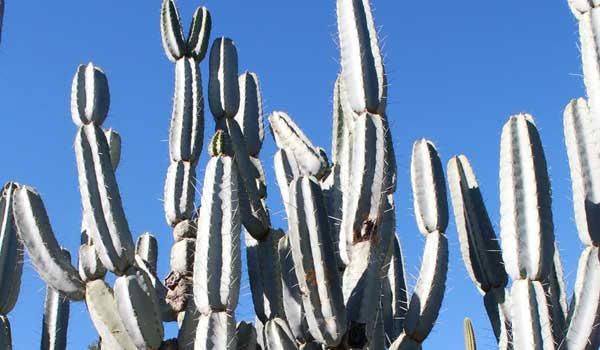
A. Caput-medusae
- Scientific name: Astrophytum caput-medusae
- Water: medium
- Light: full sun to partial shade
- Soil PH: 6.1 to 7.8
- Hardiness zone: 9 and 10
- Flower color: yellow
- Height: 1 to 6 inches
Like many other cacti in this cactus names list, A. caput-medusae is also from Mexico. With an exotic appearance, this plant may not catch everyone’s eyes at the first sight, but its beautiful golden flowers certainly will.
In its natural habitat, you’ll find this succulent 300 to 400 feet above sea level among shrubs in clusters. Unfortunately, since it has a very limited distribution, this cactus is considered critically endangered. As well as illegal over collecting and trampling by livestock.

Austrocylindropuntia Shaferi
- Water: very little
- Light: full sun to partial shade
- Soil PH: 6.0 to 8.0
- Hardiness zone: 9 and 10
- Flower color: red
- Height: 6 to 18 inches
Similar to the last plant in our cactus names list, austrocylindropuntia shaferi is another exciting plant to grow. Best known for its many small fine hairs covering it, this plant’s care is quite convenient; you just may have to choose an easier ‘pet’ name for it.
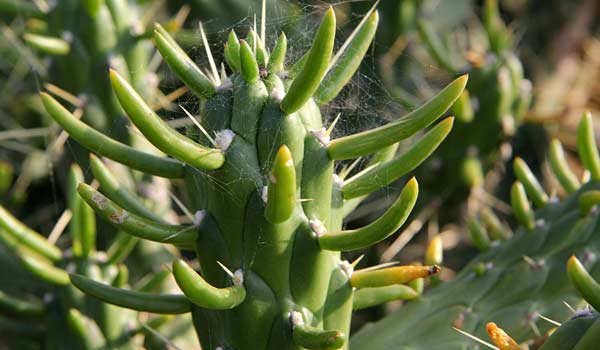
Aylostera Narvaecensis
- Water: very little
- Light: full sun to partial sun
- Soil PH: 4.0 to 6.0
- Hardiness zone: 9 to 11
- Flower color: pink, white
- Height: 1 to 6 inches
The beautiful flowers with the most subtle shade of pink make aylostera narvaecensis shine among other cactus names. It has a green to dark green stem covered by small spines that create a nice contrast with the blooms.
As a great cactus for warmer climates, it has typical water needs as the other succulents, full sun, and a well-drained potting soil mix.
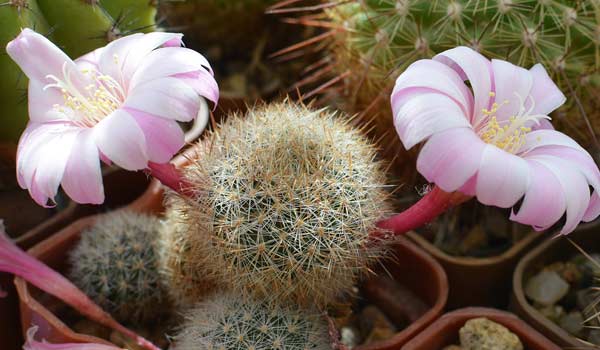
Ball Cactus
- Scientific name: Parodia magnifica
- Water: very little
- Light: full sun to part shade
- Soil PH: 6.1 to 7.8
- Hardiness zone: 9 to 11
- Flower color: yellow
- Height: 24 to 36 inches
While reviewing cactus names and pictures, you may encounter more than one plant that is known as the ball cactus, and parodia magnifica is one of them. However, this plant is also known as the balloon cactus, green ball cactus, and blue ball cactus.
Native to southern Brazil, this cactus is a species plant in the Cactaceae family. It owes its classic appearance to its solitary and globose stem with 11 to 15 ribs that are lined with bristly spines.
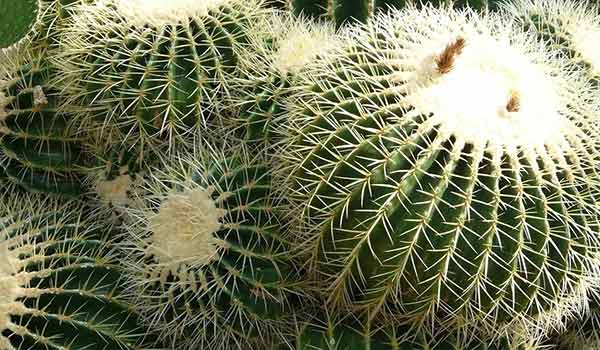
Barbed Wire Cactus
- Scientific name: Acanthocalycium glaucum
- Water: very little
- Light: full to partial sun
- Soil PH: 6.1 to 7.8
- Hardiness zone: 10 and 11
- Flower color: red, orange, gold
- Height: 1 to 6 inches
As a member of the Acanthocalycium genus, the barbed wire cactus is a decorative cactus best known for its colorful blooms and of course its large areolas with spines. Native to the humid warmth northern region of Argentina, this plant is also known as the sword pear or the triangle cactus.
There is also another popular variety of this plant, called Acanthocalycium thionanthum with roughly the same characteristics.
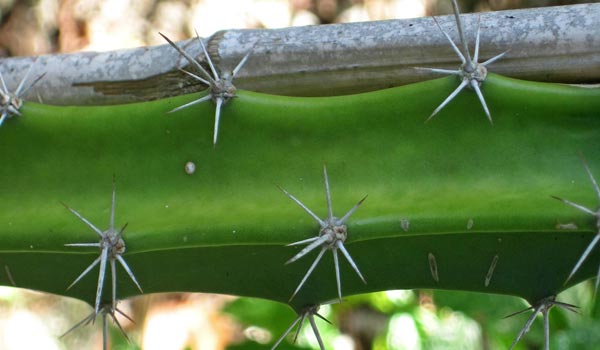
Beavertail Cactus
- Scientific name: Opuntia basilaris
- Water: very little
- Light: full sun to part shade
- Soil PH: 6.1 to 7.8
- Hardiness zone: 8 to 11
- Flower color: rose-purple
- Height: 6 to 36 inches
In case you are looking for a low-maintenance plant is for rock gardens or cactus gardens in this cactus names list, beavertail cactus can be one of your top candidates.
Opuntia basilaris is a bushy succulent shrub with flat fleshy pads that are quite similar to beaver tails. The pads are covered with small bristles with barbed tips and don’t have the long spines of other prickly pears. It’s interesting to know that during arid conditions, the color of the pads turns into an attractive purple tinge.

Bird’s Nest Cactus
- Scientific name: Mammillaria longimamma
- Water: little to medium
- Light: full sun to part shade
- Soil PH: 6.1 to 7.8
- Hardiness zone: 9 to 11
- Flower color: yellow
- Height: 3 to 9 inches
A mature bird’s nest cactus produces the most beautiful bell-shaped flowers and it is covered with white hairs. This is a tolerant plant and if you want to propagate it, we recommend using seeds or propagation by division. The only problem that you need to keep in mind, is red spider mites.
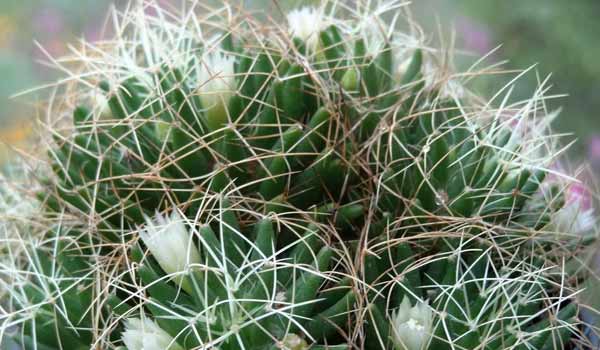
Bishop’s Cap Cactus
- Scientific name: Astrophytum tulense
- Water: very little
- Light: full sun to partial shade
- Soil PH: 6.5 to 8.0
- Hardiness zone: 9 and 10
- Flower color: yellow
- Height: 6 to 24 inches
Looking for a new houseplant in this cactus names list? The bishop’s cap cactus may be just the one that you’re looking for.
As an attractive cactus with a slow growth rate, astrophytum tulense is very similar to astrophytum myriostigma. While in fact, they have different seeds, blooms, and fruits. This plant requires patience and regular care to reach its full potential, a task that is perfectly worth your time.

Bishop’s Miter Cactus
- Scientific name: Astrophytum myriostigma
- Water: little to medium
- Light: full sun to part shade
- Soil PH: 6.1 to 7.8
- Hardiness zone: 9 to 11
- Flower color: yellow
- Height: 6 to 12 inches
This is another (notably) tolerate plant in this cactus names list. The genus name of the plant (Astrophytum) means “star plant” in Greek. Since all of the cacti in this genus look like a star when you look at them from above. As this plant matures, its ribs are covered in white and hairy spots, resembling the bishop’s traditional headdress.
To have to happiest and healthiest bishop’s miter, simply plant it in a rich and well-draining cactus soil and place it in a bright and warm spot.

Blue Barrel Cactus
- Scientific name: Ferocactus glaucescens
- Water: very little
- Light: full sun to light shade
- Soil PH: 6.1 to 7.8
- Hardiness zone: 9 to 11
- Flower color: yellow
- Height: 12 to 24 inches
This is another classic succulent in this list of cactus names and pictures, with a globose (to cylindric) stem, multiple ribs, and long spines. Native to Mexico, the blue barrel cactus produces funnel-shaped flowers that grow up to 2 inches wide.
Growing this cactus is very easy, and you only need to provide it with well-draining soil, full sun to part shade (if the spot is too hot and bright), moderate watering, and occasional feeding with a balanced liquid fertilizer.

Brain Cactus
- Scientific name: Stenocactus multicostatus
- Water: very little to medium
- Light: full sun to part shade
- Soil PH: 6.1 to 7.8
- Hardiness zone: 9 to 11
- Flower color: violet
- Height: 3 to 9 inches
Among all the exotic cacti while reviewing cactus names with pictures, the brain cactus or the wave cactus is a specimen that captures the eye instantly. The globular and wrinkled shape of this low-growing plant complements any garden or indoor space.
As you would imagine, this is a low-maintenance cactus that handles drought very well.
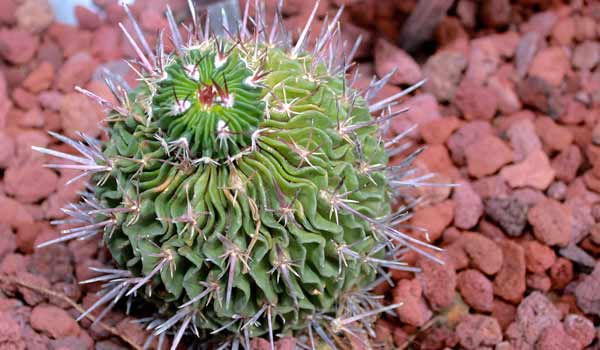
Branched Pencil Cholla
- Scientific name: Cylindropuntia ramosissima
- Water: very little
- Light: full sun
- Soil PH: 6.1 to 7.8
- Hardiness zone: 8 to 11
- Flower color: orange, pink
- Height: 12 to 72 inches
Also known as the diamond cholla, this cactus is native to the southwestern United States and northwestern Mexico. This tree-like cactus can grow as tall as 6 feet in height and has many narrow branches that are made up of cylindrical segments. The surface of these segments is divided into flat tubercles with a single long, spine (and sometimes few or no spines).
Branched pencil cholla has small blooms that have an orange, pink or brownish color, and later turn to small and dry fruits with spiny bodies.
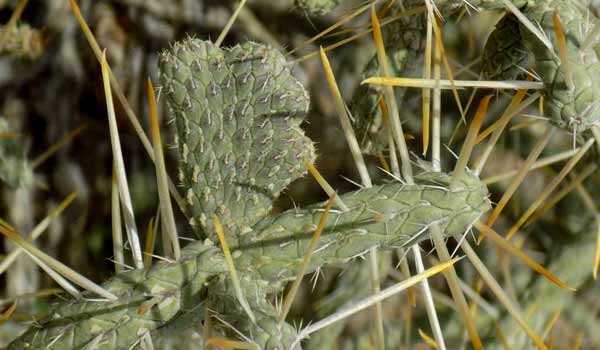
Bunny Ear Cactus
- Scientific name: Opuntia microdasys
- Water: very little
- Light: full sun to partial shade
- Soil PH: 6.1 to 7.8
- Hardiness zone: 9 to 11
- Flower color: yellow
- Height: 12 to 36 inches
Bunny ears cactus plant, AKA angel’s wings, offers both convenient care and an original appearance. It has thick pads that grow in earlike pairs and are covered with fuzzy short bristles, resembling the fur of rabbits and.
Among cactus names, this name brings good news for beginners, as everyone can grow it without worrying about the typical houseplant fuss.
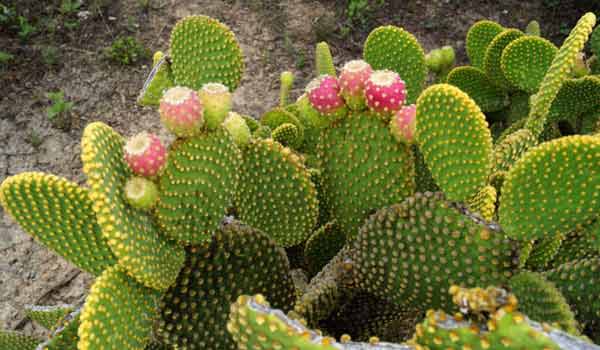
Button Cactus
- Scientific name: Epithelantha micromeris
- Water: little to medium
- Light: full sun to partial shade
- Soil PH: 6.1 to 7.8
- Hardiness zone: 9 to 11
- Flower color: pink
- Height: 1 to 6 inches
Native to Madagascar, this is another easy-to-grow and drought-tolerant plant for containers indoors in our cactus names list. This unique-looking succulent is also a perfect addition to rock gardens, as well as cacti and succulent collections.
Epithelantha micromeris care is pretty much the same as most succulents. It’s not toxic, but remember that its spines can be irritating to the skin. So always use gloves when planting or handling your button cactus.
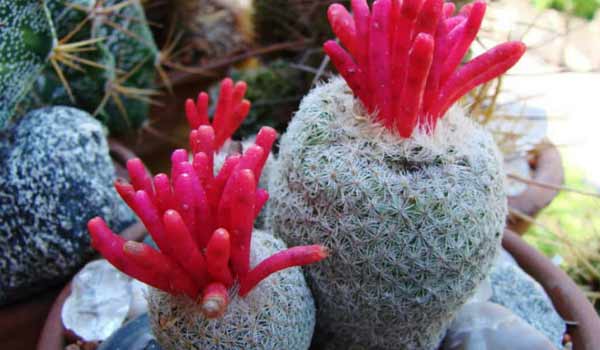
Cabega Cactus
- Scientific name: Austrocephalocereus dybowskii
- Water: very little
- Light: full to partial sun
- Soil PH: 6.1 to 7.8
- Hardiness zone: 10 and 11
- Flower color: white
- Height: 48 to 144 inches
Next on our cactus names with pictures we have canega, anotherclassic-looking plant with a furry look. You can propagate it using seeds and grow it outdoors as well. But be careful, its sharp spines can hurt you. The most important thing that this plant needs to grow happily, is enough sunlight.
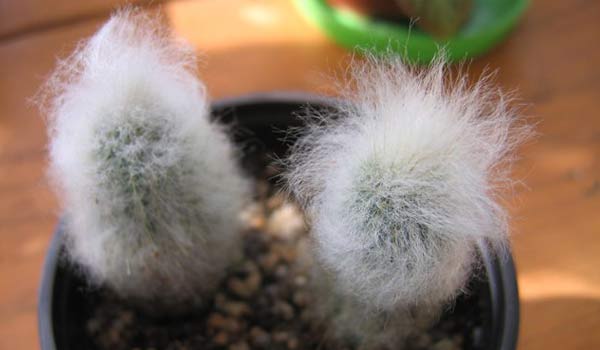
Calico Cactus
- Scientific name: Echinocereus Engelmannii
- Water: very little
- Light: full sun
- Soil PH: 6.1 to 7.8
- Hardiness zone: 7 to 10
- Flower color: pink, violet
- Height: 6 to 24 inches
Native to the southwestern US and the adjacent areas of Mexico, this cactus grows in clusters up to 20 and more stems. Not a lot of people grow this plant, as it has a very slow growth rate and doesn’t bloom until it has reached its mature size.
Calico is best known for its showy bright magenta blooms in cactus names that appear in April to late May. It also has very spiny fruit (and they are easily detached). When unripe, it is green, but turns pink and dries when ripe, containing its black seeds.
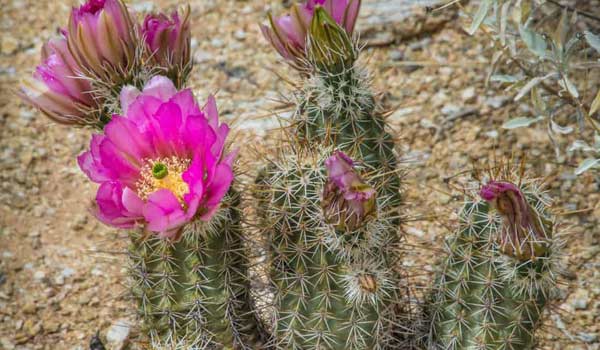
Candelabra Cactus
- Scientific name: Myrtillocactus cochal
- Water: very little to medium
- Light: full sun
- Soil PH: 6.1 to 7.8
- Hardiness zone: 9 to 11
- Flower color: white, yellow-green
- Height: 8 to 10 feet
This huge plant has multiple dark green branches. These branches have a central spine and six to eight ribs. In late spring through early summer, you can enjoy its stunning, blooms that later turn to edible and slightly acidic red fruits. You can grow the candelabra cactus in containers, or mix it with other succulents in rock gardens.

Candy Barrel Cactus
- Scientific name: Ferocactus wislizenii
- Water: very little
- Light: full sun
- Soil PH: 6.1 to 7.8
- Hardiness zone: 9 to 11
- Flower color: yellow, orange, red
- Height: 24 to 36 inches
Continuing our list of types of cactus with names, we have another cylindrical cactus called ferocactus wislizenii. This is a rare cactus with 13 to 25 and very sharp yellow-red or purple-red spines. It produces gorgeous flowers and later fruits that attract different animals like birds and small mammals.
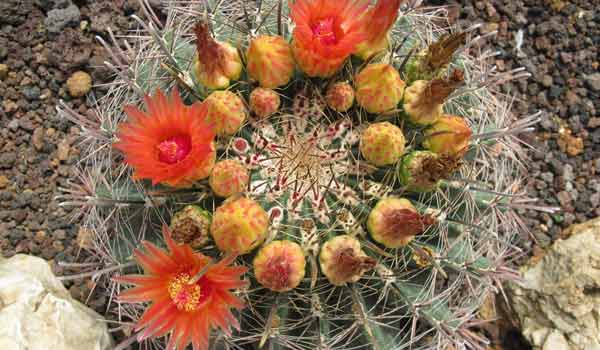
Carmine Cob Cactus
- Scientific name: Echinopsis backebergii
- Water: little to medium
- Light: full to partial sun
- Soil PH: 6.1 to 7.8
- Hardiness zone: 10 and 11
- Flower color: pink, red
- Height: 1 to 6 inches
Looking for more small and cute options among cactus names? Consider growing carmine cob cactus. The loveable size isn’t all this plant has to offer; it is also drought-tolerant and produces eye-catching flowers.
This flowering plant is native to eastern Bolivia and southern Peru. It has one or clustered globose stems up to about 15 ribs grey-brown spines that cover it.

Eve’s Needle Cactus
- Scientific name: Austrocylindropuntia exaltata
- Water: very little
- Light: full sun
- Soil PH: 6.1 to 7.8
- Hardiness zone: 9 and 10
- Flower color: red
- Height: 72 to 180 inches
The bright green color of the eve’s needle cactus with its many small-looking leaves captures the eye when reading through cactus names with pictures.
This plant causes no problems for you or your pets, and you can easily propagate it using offsets. You can grow austrocylindropuntia exaltata outdoors as well, where it can get the strong light that it need. But remember that it doesn’t handle cold well.
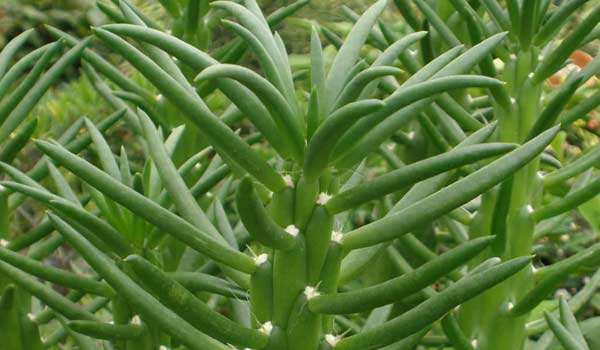
Ladyfinger Cactus
- Scientific name: Mammillaria elongata
- Water: little to medium
- Light: partial sun
- Soil PH: 6
- Hardiness zone: 9 to 10
- Flower color: white, yellow, pink
- Height: up to 8 inches
This is another beginner-friendly plant in this cactus names list. As it grows at a slow rate, its tubes form dense clusters, with petite flowers in the spring. This cactus is suitable for growing both indoors and outdoors.
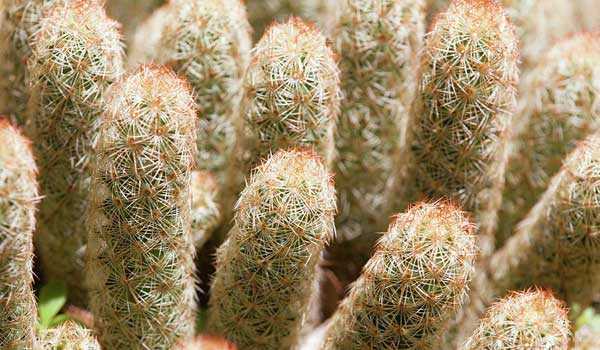
Living Rock Cactus
- Scientific name: Ariocarpus lloydii
- Water: very little
- Light: full sun
- Soil PH: 6.1 to 7.8
- Hardiness zone: 9 to 11
- Flower color: pink
- Height: 1 to 6 inches
Next on the cactus names with pictures, we have the living rock cactus also called false peyote, chautle, dry whiskey, and star cactus. This plant is best known for its beautiful shape and its unique stem green with a dark green to yellowish color.
With its pink-purple flowers, this succulent type is an eye-catching addition to your garden or indoor spaces.
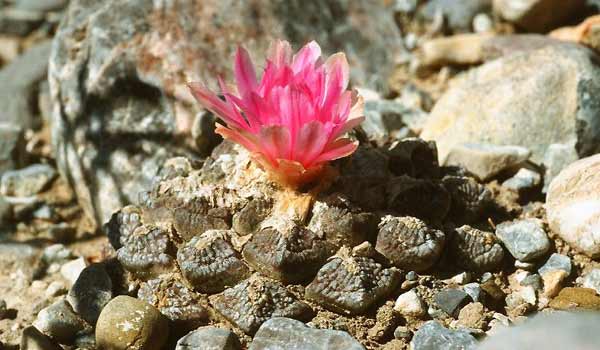
Neon Broom Cactus
- Scientific name: Arrojadoa penicillata
- Water: very little
- Light: full to partial sun
- Soil PH: 6.1 to 7.8
- Hardiness zone: 10 and 11
- Flower color: pink, purple
- Height: 24 to 48 inches
A list of cactus names with pictures cannot be complete without tropical cacti. Neon broom cactus has delicate long pencil-like upright segments, which are separated by fuzzy brown spines.
The pinkish-purple purple flowers of this charming cactus open at night, waiting for moths and beetles to be pollinated. It is an excellent cactus for growing outdoors. In rock gardens, it can trail the ground. You can also grow them or under taller shrubs, so the neon broom can lean on them for support.
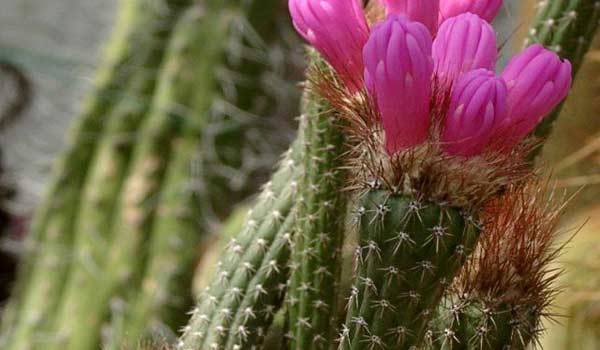
Old Man Cactus
- Scientific name: Cephalocereus senilis
- Water: little
- Light: full sun
- Soil PH: 6.1 to 7.8
- Hardiness zone: 9 and 10
- Flower color: pink
- Height: up to 20 feet
Resembling a shaggy old man, this cactus brings a lot of character to your succulent collection unlike other plants in this cactus names list. Native to Guanajuato and Hidalgo in Mexico, it is also known as the old man of the Andes cactus, hairy old man cactus, and bearded cactus.
It has a long and columnar shape and can grow up to 20 feet in the wild. But when you grow its cutting or seed in a container, its size will be limited and suitable for indoors. Since it cannot take the weight of side branches, the old man cactus usually grows in unbranched stems.
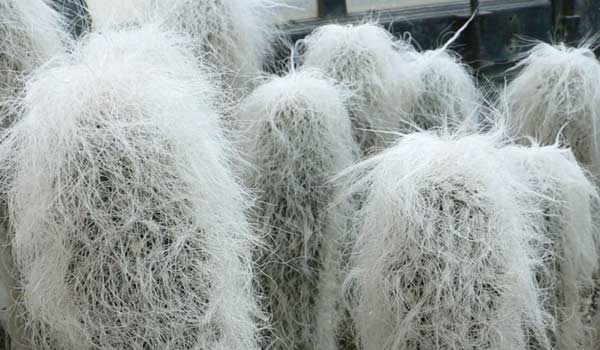
Prickly Pear Cactus
- Scientific name: Brasiliopuntia brasiliensis
- Water: very little
- Light: full sun
- Soil PH: 6.1 to 7.8
- Hardiness zone: 10 and 11
- Flower color: red, pink, yellow
- Height: 12 to 40 feet
Continuing our list of cactus names with pictures, we have another tree-like cactus that can reach up to 40 feet and even in height. Originally found in Brazil, Peru, Paraguay, Bolivia, and Argentina, this is a super popular plant that you might mistake with Prickly Pear cacti from the Opuntia genus.
All that prickly pear cactus needs to grow best, bloom, and produce fruit, is a sunny and warm environment similar to their natural habitat, not too much water, and porous soil with suitable drainage.

Sea Urchin Cactus
- Scientific name: Echinopsis cactus
- Water: little to medium
- Light: partial sun
- Soil PH: 6.1 to 7.8
- Hardiness zone: 6 to 10
- Flower color: white, pink
- Height: up to 5 feet
Also known as the Easter lily cactus, sea cactus, Hedgehog cactus, and sometimes Torch cactus (Trichocereus) this beautiful plant is originally from South America. There are various Echinopsis Cactus types that differ in form and flower color. It’s good to know that Trichocereus and Lobivia generas are included with Echinopsis.

Snake Cactus
- Scientific name: Arthrocereus rondonianus
- Water: very little
- Light: full to partial sun
- Soil PH: 5.0 to 7.0
- Hardiness zone: 10 and 11
- Flower color: pink
- Height: 6 to 24 inches
The snake cactus is a night-blooming cactus with bright pink and scented flowers; colors that distinguish it from other night-blooming cacti.
Arthrocereus rondonianus has low shrubby stems that separate from the bottom. They can reach up to 3 feet with a little more than 2 inches in diameter. An acid-neutral and well0draining soil, full sun, and very little water are all you need to have a happy and healthy snake cactus.
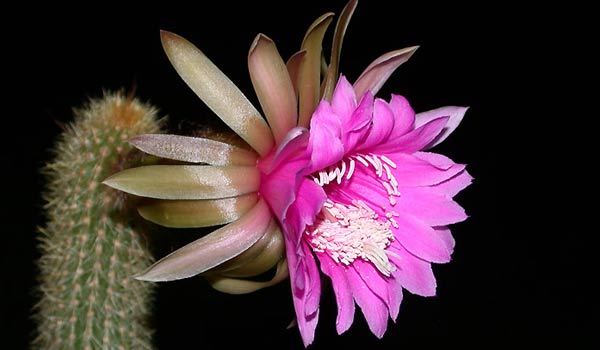
Star Rock Cactus
- Scientific name: Ariocarpus confusus
- Water: very little
- Light: full sun
- Soil PH: 7.6 to 7.8
- Hardiness zone: 9
- Flower color: pink, white
- Height: 1 to 6 inches
Continuing our cactus names list, we get to the star rock cactus; a super popular but hard-to-find cactus. It is native to Mexico, star rock cactus is actually one of the largest and fastest-growing species from the genus Ariocarpus, while the genus itself is famous for a slow growth rate.
With attractive blooms and an exotic shape for a cactus, growing Ariocarpus confuses is a joy everyone should experience.
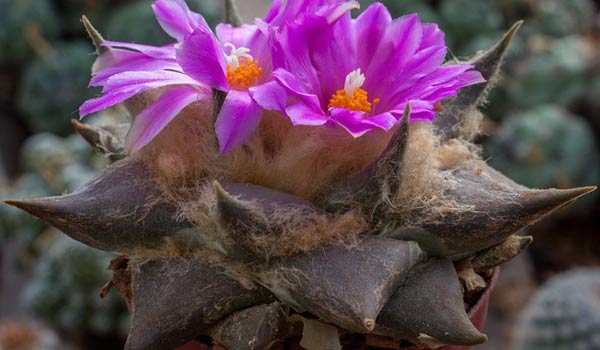
Totem Pole Cactus
- Scientific name: Pachycereus schottii monstrosus
- Water: little
- Light: full sun
- Soil PH: 6.1 to 7.8
- Hardiness zone: 9 to 11
- Flower color: pink
- Height: 10 to 12 feet
Native to Mexico, pachycereus schottii monstrosus is a columnar cactus that can grow up to 12 feet in its natural habitat. It has 5 to 9 ribs, a short trunk, and tall medium green-colored stems branch from it. These branches may fall due to strong winds and root along their side.
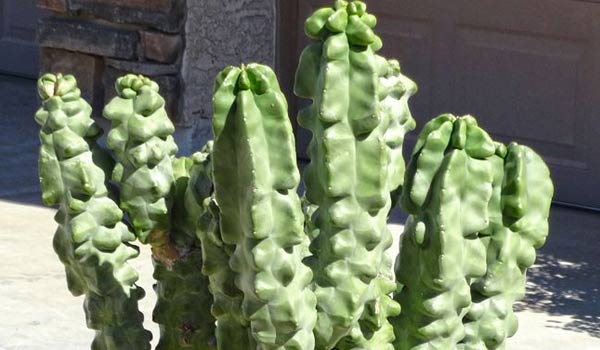
And that is 30 cactus names with pictures. Hopefully, you have found the next green friend that you were looking for.
Happy gardening!
- In this post:
- Cactus Names List with Pictures



